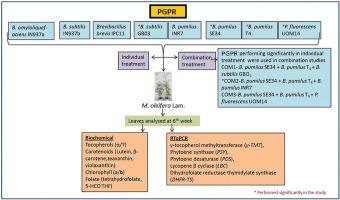当前位置:
X-MOL 学术
›
Phytochemistry
›
论文详情
Our official English website, www.x-mol.net, welcomes your
feedback! (Note: you will need to create a separate account there.)
Biochemical and molecular insights of PGPR application for the augmentation of carotenoids, tocopherols, and folate in the foliage of Moringa oleifera
Phytochemistry ( IF 3.2 ) Pub Date : 2020-11-01 , DOI: 10.1016/j.phytochem.2020.112506 Priyanka P Sonbarse 1 , Kamireddy Kiran 1 , Preksha Sharma 2 , Giridhar Parvatam 1
Phytochemistry ( IF 3.2 ) Pub Date : 2020-11-01 , DOI: 10.1016/j.phytochem.2020.112506 Priyanka P Sonbarse 1 , Kamireddy Kiran 1 , Preksha Sharma 2 , Giridhar Parvatam 1
Affiliation

|
Plant Growth Promoting Rhizobacteria (PGPR) were utilized to contemplate their impact on the foliage of Moringa oleifera and examined for changes in tocopherols, chlorophyll, carotenoids, and folate in the sixth week. Among the eight treatments, Bacillus subtilis GB03, B. pumilus SE34, B. pumilus T4, and Pseudomonas fluorescens UOM14 improved α-tocopherol (10-14 fold) and β-carotene (1-1.40 fold) altogether significantly (P ≤ 0.05). The most significant improvement in folate content was apparent for B. subtilis IN937B (5.47 fold) trailed by B. pumilus SE34 (5.05 fold) and B. pumilus T4 (5.12 fold) treatments. P. fluorescens UOM14 indicated remarkable improvement in Chl a (0.39 fold) and Chl b (0.44 fold) content. Organisms showing a significant increase for the analyzed molecules in individual treatment were blended in different combinations and were used for the next set of treatments. Of all the three combinations, Combination 2 (COM2-B. pumilus SE34 + B. pumilus T4 + B. pumilus INR7) showed the maximum increase in α-tocopherol (8.46 fold) and γ-tocopherol (8.45 fold), followed by Combination 3 (COM3-B. pumilus SE34 + B. pumilus T4 + P. fluorescens UOM14) (5.93 and 3.65 fold). On the whole COM2 containing different strains of B. pumilus was found to enhance the targeted metabolites in foliage significantly. Real-time PCR studies were conducted for the biochemical pathway genes of the targeted molecules, including, γ-tocopherol methyltransferase (γ-TMT), phytoene synthase (PSY), phytoene desaturase (PDS), lycopene β cyclase (LBC) and dihydrofolate reductase thymidylate synthase (DHFR-TS). All the selected genes exhibited an up-regulation compared to control, similar to the biochemical output. Our investigation provides the strong evidence that PGPR can be viably utilized in combination to enhance the quality of the food crops.
中文翻译:

PGPR 应用的生化和分子见解,用于增加辣木叶子中的类胡萝卜素、生育酚和叶酸
植物生长促进根际细菌 (PGPR) 被用来考虑它们对辣木叶子的影响,并在第六周检查生育酚、叶绿素、类胡萝卜素和叶酸的变化。在8个处理中,枯草芽孢杆菌GB03、短小芽孢杆菌SE34、短小芽孢杆菌T4和荧光假单胞菌UOM14共同显着提高α-生育酚(10-14倍)和β-胡萝卜素(1-1.40倍)(P≤0.05) . 枯草芽孢杆菌 IN937B(5.47 倍)的叶酸含量的最显着改善明显,其次是短小芽孢杆菌 SE34(5.05 倍)和短小芽孢杆菌 T4(5.12 倍)处理。荧光假单胞菌 UOM14 表明 Chl a(0.39 倍)和 Chl b(0.44 倍)含量显着改善。在单独的处理中显示出显着增加的分析分子的有机体以不同的组合混合,并用于下一组处理。在所有三种组合中,组合 2(COM2-短小芽孢杆菌 SE34 + 短小芽孢杆菌 T4 + 短小芽孢杆菌 INR7)的 α-生育酚(8.46 倍)和 γ-生育酚(8.45 倍)增幅最大,其次是组合3(COM3-短小芽孢杆菌 SE34 + 短小芽孢杆菌 T4 + 荧光假单胞菌 UOM14)(5.93 和 3.65 倍)。总体而言,发现含有不同短小芽孢杆菌菌株的 COM2 显着增强了叶子中的靶向代谢物。对目标分子的生化途径基因进行实时 PCR 研究,包括 γ-生育酚甲基转移酶 (γ-TMT)、八氢番茄红素合酶 (PSY)、八氢番茄红素去饱和酶 (PDS)、番茄红素 β 环化酶 (LBC) 和二氢叶酸还原酶胸苷酸合酶 (DHFR-TS)。与对照相比,所有选定的基因都表现出上调,类似于生化输出。我们的调查提供了强有力的证据,证明可以有效地结合使用 PGPR 来提高粮食作物的质量。
更新日期:2020-11-01
中文翻译:

PGPR 应用的生化和分子见解,用于增加辣木叶子中的类胡萝卜素、生育酚和叶酸
植物生长促进根际细菌 (PGPR) 被用来考虑它们对辣木叶子的影响,并在第六周检查生育酚、叶绿素、类胡萝卜素和叶酸的变化。在8个处理中,枯草芽孢杆菌GB03、短小芽孢杆菌SE34、短小芽孢杆菌T4和荧光假单胞菌UOM14共同显着提高α-生育酚(10-14倍)和β-胡萝卜素(1-1.40倍)(P≤0.05) . 枯草芽孢杆菌 IN937B(5.47 倍)的叶酸含量的最显着改善明显,其次是短小芽孢杆菌 SE34(5.05 倍)和短小芽孢杆菌 T4(5.12 倍)处理。荧光假单胞菌 UOM14 表明 Chl a(0.39 倍)和 Chl b(0.44 倍)含量显着改善。在单独的处理中显示出显着增加的分析分子的有机体以不同的组合混合,并用于下一组处理。在所有三种组合中,组合 2(COM2-短小芽孢杆菌 SE34 + 短小芽孢杆菌 T4 + 短小芽孢杆菌 INR7)的 α-生育酚(8.46 倍)和 γ-生育酚(8.45 倍)增幅最大,其次是组合3(COM3-短小芽孢杆菌 SE34 + 短小芽孢杆菌 T4 + 荧光假单胞菌 UOM14)(5.93 和 3.65 倍)。总体而言,发现含有不同短小芽孢杆菌菌株的 COM2 显着增强了叶子中的靶向代谢物。对目标分子的生化途径基因进行实时 PCR 研究,包括 γ-生育酚甲基转移酶 (γ-TMT)、八氢番茄红素合酶 (PSY)、八氢番茄红素去饱和酶 (PDS)、番茄红素 β 环化酶 (LBC) 和二氢叶酸还原酶胸苷酸合酶 (DHFR-TS)。与对照相比,所有选定的基因都表现出上调,类似于生化输出。我们的调查提供了强有力的证据,证明可以有效地结合使用 PGPR 来提高粮食作物的质量。











































 京公网安备 11010802027423号
京公网安备 11010802027423号